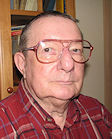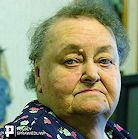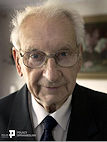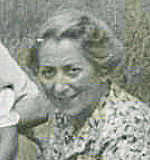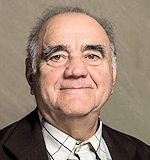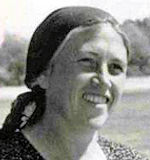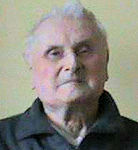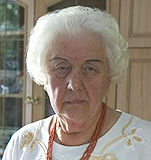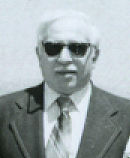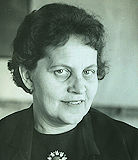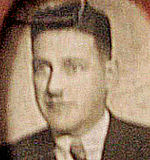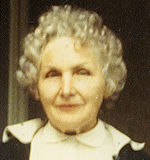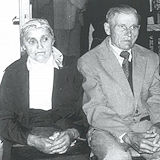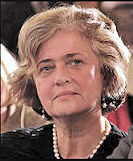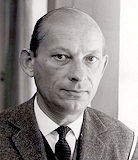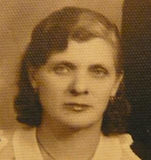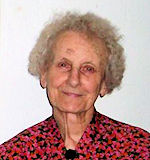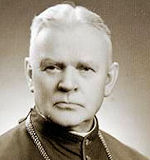The Częstochowa Righteous
- Honouring True Heroes
In this section of our website, we honour the “Częstochowa Righteous” – people, who risked their lives and the lives of their families, to extend help to Jews during World War II. These individuals are true heroes and, just as we endeavour to preserve the memory of those who either perished or survived during the Holocaust, we also have an obligation to preserve the memory of those who came to the aid of Jews in those dangerous times.
This listing will not only include those who performed such acts of heroism within Częstochowa and the surrounding region, but will also include individuals from Częstochowa who acted nobly elsewhere.
In composing our list, we draw upon the resources of Yad Vashem, a project of the World Holocaust Remembrance Centre in Jerusalem and the “Polish Righteous – Restoring Forgetten Memory”, a project of the POLIN Museum of the History of Polish Jews in Warsaw. We also include numerous others who, due to a lack of sufficient, first-hand evidence, have not been officially recognised as “Righteous” by Yad Vashem.
When reading their stories, it should be remembered that, in occupied Poland, the penalty for aiding Jews was death. In some cases, the Germans applied a collective responsibility which meant not only death to the person who extended that aid, but ALSO death to that person’s family.
This fact not only makes their deeds even more heroic and courageous, but it means that there are also “Righteous” about whom we will never know – those who were discovered by the Nazis and where they, their family and the Jews they were aiding were all shot – thereby leaving no one to even remember their names. May these heroes, together with those whom they endeavoured to help, rest in peace.
SIMPLY CLICK ON EACH NAME TO READ THEIR STORIES OF HEROISM.
During the German occupation of Poland, Zofia Batawia-Kłodnicka, a resident of Warsaw, traveled to Częstochowa to assist the Majzner family, with whom she was friendly. Upon her arrival, she found that she was unable to enter the ghetto, which was hermetically sealed. She managed to find their little son, Janek, whom she took back with her to Warsaw. On 23rd December 1982, Zofia was recognised as Righteous Among the Nations.
Click HERE to read her story.
(Courtesy: Yad Vashem – a project of the World Holocaust Remembrance Centre)
After the death of her husband and the rest of her family prior to the final liquidation of the Częstochowa ghetto, Roma Frydman succeeded in placing her six-year-old daughter, Ilona, in the care of Kazimiera Berczyńska, an elderly Polish teacher, who lived together with her son, Wacław, and his wife, Zofia. On 19th March 1986, Kazimiera, her son and daughter-in-law were recognised as Righteous Among the Nations.
Click HERE to read their story.
(Courtesy: Yad Vashem – a project of the World Holocaust Remembrance Centre)
For almost two years, during the Second World War, Józefa and Antoni Błoński, and Marta and Andrzej Skop hid teenager Tzvi Norich on their farms in Woźniki and Koziegłowy near Częstochowa. In 2010, Józefa and Antoni Błoński, and Marta and Andrzej Skop were recognised as Righteous Among the Nations.
Click HERE to read their story.
(Courtesy: “Polish Righteous – Recalling Forgotten Memory”
– a project of the POLIN Museum of the History of Polish Jews)
In Częstochowa in 1943, Ita Dimant (née: Miodownik) and Yitzchak Berman found refuge, from the Germans who were searching for them, in the apartment of Henryk and Aniela Brust. The Brust family regarded their rescue operations as part of the war against a common enemy. On 4th September 1979, Henryk and Aniela Brust were recognised as Righteous Among the Nations.
Click HERE to read their story.
(Courtesy: Yad Vashem – a project of the World Holocaust Remembrance Centre)
In June 1943, Tzvi (Cwi; Jacek) Wiernik and Zyskind Szmuelewicz were sent to the HASAG Eisenhüttenwerke camp at the Raków foundry in Częstochowa. Through a friend, they became acquainted with Marian Brust, a veteran worker at the foundry. With the active assistance of Marian’s wife, Lucyna, the Brusts’ home became a centre for the relief of persecuted Jews. On 22nd December 1983, Marian and Lucyna Brust were recognised as Righteous Among the Nations.
Click HERE to read their story.
(Courtesy: Yad Vashem – a project of the World Holocaust Remembrance Centre)
As a doctor in Częstochowa, Tadeusz Ferens was known to many of its residents. In 1942, one of his pre-War friends and patients, Rut Asz, the daughter of Częstochowa Chief Rabbi Nachum Asz, asked him to help her reach the “Aryan side”. Jerzy, his son (pic left), recalls the night well. On 14th January 1985, Tadeusz and Wanda Ferens, as well as Irena Pawłowska, were recognised as Righteous Among the Nations.
Click HERE to read their story.
(Courtesy: “Polish Righteous – Recalling Forgotten Memory”
– a project of the POLIN Museum of the History of Polish Jews)
Maria Kos (pic left) and Małgosia Korngold became good friends in their high school years. After the Częstochowa ghetto was established, Maria would bring her friend’s family basic amenities from the “Aryan side”. In 1984, Maria was recognised as Righteous Among the Nations.
Click HERE to read her story.
(Courtesy: “Polish Righteous – Recalling Forgotten Memory”
– a project of the POLIN Museum of the History of Polish Jews)
Bogdan Jastrzębski (pic left) and Krystyna Geisler met in 1940. Despite the hatred all around them, they quickly developed a beautiful bond. Bogdan and his mother rescued Krystyna and her father Arnold. In 1994, Maria and Bogdan Jastrzębski were recognised as Righteous Among the Nations.
Click HERE to read their story.
(Courtesy: “Polish Righteous – Recalling Forgotten Memory”
– a project of the POLIN Museum of the History of Polish Jews)
When Stanisława Klewicka received a postcard, postmarked “Częstochowa”, from her childhood friend Jadzia stating that she was ill, she immediately went there. Together with her son Leszek, she brought six Częstochowa Jews to their two-storey villa in Radość near Warsaw, and helped them to survive the War. On 8th September 1993, Stanisława and Leszek were recognised as Righteous Among the Nations.
Click HERE to read their story.
(Courtesy: “The Polish Righteous – Restoring Forgotten Memory”
– a project of the POLIN Museum of the History of Polish Jews)
During Nazi occupation, Maria and Anna Koźmińska lived in Częstochowa. During the years 1943-1945, they hid a Jewish boy, Abraham Jabłoński, an escapee from the Częstochowa ghetto, and three other Jews. On 11th February 1991, Maria and Anna Kożmińska were recognised as Righteous Among the Nations.
Sadly, Anna Kożmińska passed away on 24th March 2021. She was almost 102 years old.
Click HERE to read their story.
(Courtesy: “Polish Righteous – Recalling Forgotten Memory”
– a project of the POLIN Museum of the History of Polish Jews)
Częstochowa-born Piotr Kwarciak lived in the suburbs of Dubno (then Wołyń county, today Ukraine) together with his wife Maria (née Broczek) and their sons Feliks, Anatoliusz and Alfred. One night in August 1942, fifteen fugitives from the Szybna Mountain execution site, including six children, came to the Kwarciaks’ house, asking for help. The Kwarciaks knew them all from before the War and decided to help. In 1992, Piotr, Maria and their three sons were all recognised as Righteous Among the Nations.
Click HERE to read their story.
(Courtesy: “Polish Righteous – Recalling Forgotten Memory”
– a project of the POLIN Museum of the History of Polish Jews)
In August 1942, Helena Fiszhaut obtained false documents for herself and her daughter. They managed to escape from the Warsaw ghetto and headed to the home of Aldona Lipszyc, Helena’s high school friend. Aldona took them in and, after a few weeks, Ela was placed into a convent orphanage in Częstochowa. Helena remained with Aldona until the outbreak of the Warsaw Uprising.. In 1996, Aldona Liszyc was posthumously recognised as Righteous Among the Nations.
Click HERE to read her story.
(Courtesy: “Polish Righteous – Recalling Forgotten Memory”
– a project of the POLIN Museum of the History of Polish Jews)
Stanisław and Honorata Mach lived in Częstochowa. Their daughter, Wanda, was a school friend of Lula Gliksman (later Zofia Barlas). When the Jews were moved into the ghetto, the two girls lost touch. In winter 1942-43, Lula appeared at the Machs’ house asking for shelter. On 29th June 1995, Stanisław, Honorata and Wanda Mach were recognised as Righteous Among the Nations.
Click HERE to read their story.
(Courtesy: Yad Vashem – a project of the World Holocaust Remembrance Centre)
Wilchelm Maj extracted a little girl, Ida Paluch, from the Sosnowiec ghetto and took the child to his home in Częstochowa. Although his wife, Józefa, was pregnant, she did not hesitate to warmly welcome Ida into her home.. On 22nd March 2011, Wilchem and Józefa Maj were recognised as Righteous Among the Nations.
Click HERE to read their story.
(Courtesy: Yad Vashem – a project of the World Holocaust Remembrance Centre)
During World War II, in Częstochowa, Maria Markowska, together with her daughters Natalia Matysiak (nee Markowska) and Cecylia Łosik (nee Markowska), hid Danuta Reichental (nee Perelmuter), providing her with goods necessary for life and with false documents. On 24th March 2018, Maria, Natalia and Cecylia were recognised as Righteous Among the Nations.
Click HERE to read their story.
(Courtesy: Yad Vashem – a project of the World Holocaust Remembrance Centre)
In the summer of 1942, Sara Rajnherc fled with her two children during the final liquidation of the ghetto of Pabianice, near Łódż. After much suffering and hardship, the three fugitives arrived in the village of Janów, near Częstochowa, where they found refuge in the home of Józef and Stanisława Mencik. On 27th January 1993, Józef and Stanisława Mencik were recognised as Righteous Among the Nations.
Click HERE to read their story.
(Courtesy: Yad Vashem – a project of the World Holocaust Remembrance Centre)
In the autumn of 1942, during the deportations from the Częstochowa ghetto, Yitzhak and Bela Horowitz managed to escape from the ghetto together with their five-year-old son. Through a relative, who was hiding on the “Aryan side”, they were referred to the home of Wacław Miłowski, a factory worker, who, together with his wife Helena, agreed to provide refuge for the desperate refugees. On 24th January 1978, Wacław and Helena Miłowski were recognised as Righteous Among the Nations.
Click HERE to read their story.
(Courtesy: Yad Vashem – a project of the World Holocaust Remembrance Centre)
In the autumn of 1942, Franka Beatus managed to escape during the deportations from the Częstochowa ghetto. She somehow arrived at the home of Zygmunt and Henryka Mielczarek, friends of the family, and after asking them to hide her, they provided her with protection and prepared a well-concealed hiding place for her in their apartment. On 3rd March 1983, Zygmunt and Henryka Mielczarek were recognised as Righteous Among the Nations.
Click HERE to read their story.
(Courtesy: Yad Vashem – a project of the World Holocaust Remembrance Centre)
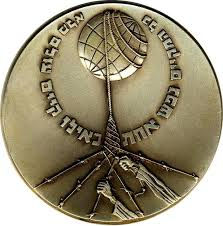
From December 1941, in Częstochowa, the Mrożek family provided shelter and false documents for six Jews, among whom were two members of the Weksler family. On 29th January 1992, Stanisław, Waleria and Daniela Mrożek were all recognised as Righteous Among the Nations.
Click HERE to read their story.
(Courtesy: “Polish Righteous – Recalling Forgotten Memory”
– a project of the POLIN Museum of the History of Polish Jews)
Fritz Mühlhof was born in Hagen/Westphalia in 1902. During World War II, he commanded the factory guard at Raków near Częstochowa. In that capacity, he supported the activities of the underground Jewish Fighting Organisation (ŻOB) and allowed its leaders to move freely between the labour camp at Raków and the outside world. On 21st September 1978, Fritz Mühlhof was recognised as Righteous Among the Nations.
Click HERE to read his story.
(Courtesy: Yad Vashem – a project of the World Holocaust Remembrance Centre)
In 1943, in the Myszków District near Częstochowa, fifteen-year-old Jerzy Nędza (pic left as an adult) came upon a terrified, half-naked boy, Mojżesz Rozenbaum. He decided to bring him home to his parents, Franciszek and Elżbieta (née Napora), who, together with numerous family members, ran a large farm. On 1st April 2001, Franciszek, Elżbieta and Jerzy Nędza were all recognised as Righteous Among the Nations.
Click HERE to read their story.
(Courtesy: “Polish Righteous – Recalling Forgotten Memory”
– a project of the POLIN Museum of the History of Polish Jews)
In 1942, after the Germans had begun liquidating the Włoszczowa ghetto, in the Kielce district, Rachel Rosenzwieg appealed to her friend, Konrad Nowak, for help. Risking his life, Nowak moved her and her brother, Israel, to Częstochowa. Israel entered the local ghetto, where he found work in the HASAG factory. Nowak found Rachel a place to stay with a local Polish family, introducing her as his fiancée. On 25th March 1996, Konrad Nowak was recognised as Righteous Among the Nations.
Click HERE to read his story.
(Courtesy: Yad Vashem – a project of the World Holocaust Remembrance Centre)
When the presence of two Jewish workers, in his glass-making factory in Częstochowa, began to arouse suspicion, Mieczysław Rylski reached out to the Albertine convent in the city. He explained the situation to the mother superior, Sister Vita (Józefa Pawłowska), who permitted the girls to move into the nuns’ house. At the convent, only she knew that the girls were Jewish. On 21st January 2014, Józefa Pawłowska was recognised as Righteous Among the Nations.
Click HERE to read her story.
(Courtesy: Yad Vashem – a project of the World Holocaust Remembrance Centre)
In 1941, before Irena Weksztein’s parents were deported from Częstochowa to a forced-labor camp, they found a way to make contact with Kamilla Pelc, who, motivated by her love of humanity and without asking for or receiving any remuneration, agreed to take their two-year-old daughter under her care. On 30th March 1998, Kamilla Pelc was recognised as Righteous Among the Nations.
Click HERE to read her story.
(Courtesy: Yad Vashem – a project of the World Holocaust Remembrance Centre)
Mikołaj Pietrzak and Samuel Broder knew each other well before the War. During the occupation, the Broder family moved from Warsaw to Częstochowa. Freeing Samuel’s daughter,Sonia, from the ghetto was a difficult task. Mikołaj could not enter the ghetto, so he sent his own 12-year-old daughter, Helena. On 8th May 1979, Mikołaj and Helena (pic left, as an adult), were both recognised as Righteous Among the Nations.
Click HERE to read their story.
(Courtesy: “Polish Righteous – Recalling Forgotten Memory”
– a project of the POLIN Museum of the History of Polish Jews)
After entering the Łódż ghetto three times to escort out three Jewish teenage girls, Natalia Drożdż (nee Pisula) hid two of them, Rozia Paryż and Golda Fogelman, in her apartment and placed Golda’s sister, Pesa Fogelman, in her parents’ home in the village of Herby near Częstochowa. On 29th November 1979, Michał (pic left), his wife and daughter were recognised as Righteous Among the Nations.
Click HERE to read their story.
(Courtesy: Yad Vashem – a project of the World Holocaust Remembrance Centre)
Between 1916 and 1923, Bronisława Płaskacz (pic left) was a nanny for the Bugajer family in Częstochowa. During the occupation, when they were interned in the ghetto, Płaskacz visited them regularly and offered them her assistance. When the situation worsened, Płaskacz tried to persuade the Bugajer family to flee to the “Aryan side” of the city. On 14th December 1965, Bronisława Płaskacz was recognised as Righteous Among the Nations.
Click HERE to read her story.
(Courtesy: Yad Vashem – a project of the World Holocaust Remembrance Centre)
Among Stefan Rak’s many Jewish friends were Salomon Markowicz, a work colleague, his wife, Rozalia, Hela Parnes, and her brother. In June 1943, after the liquidation of the Częstochowa ghetto, the Markowicz couple, Hela and her brother fled to the Raks’ home asking for refuge. On 24th February 1988, Stefan Rak, his mother, Agnieszka Rak and his sister, Helena Błaszczyk (née Rak) were recognised as Righteous Among the Nations.
Click HERE to read their story.
(Courtesy: Yad Vashem – a project of the World Holocaust Remembrance Centre)
While in Warsaw, Mieczysław Rylski, a glass manufacturer from Częstochowa, met the sisters, Paula and Hanna Kornblum. Finding themselves without employment and in danger because of the uprising, the girls approached him for help. They told him honestly that they were Jewish, but Rylski said that if they could get fake work permits, he would employ them. On 21st January 2014, Mieczysław Rylski was recognised as Righteous Among the Nations.
Click HERE to read his story.
(Courtesy: Yad Vashem – a project of the World Holocaust Remembrance Centre)
The Sikora family lived in Częstochowa, in a company-owned settlement of the Pelcery textile factory, where Stefan (pic left) was employed. Under Nazi occupation, the Germans merged Pelcery with the factory owned by the HASAG corporation and began manufacturing arms. On 27th January 1982, Aleksandra was recognised as Righteous Among the Nations. On 12th September 1990, Stefan and Jerzy were recognised as Righteous Among the Nations.
Click HERE to read their story.
(Courtesy: “Polish Righteous – Recalling Forgotten Memory”
– a project of the POLIN Museum of the History of Polish Jews)
For almost two years, during the Second World War, Marta and Andrzej Skop and Józefa and Antoni Błoński hid teenager Tzvi Norich on their farms in Koziegłowy and Woźniki, near Częstochowa. In 2010, Marta and Andrzej Skop and Józefa and Antoni Błoński were recognised as Righteous Among the Nations.
Click HERE to read their story.
(Courtesy: “Polish Righteous – Recalling Forgotten Memory”
– a project of the POLIN Museum of the History of Polish Jews)
When Yitzhak and Bela Horowitz and their son, Edward, were in hiding in Częstochowa, Aleksander Sosna helped them by providing them with funds for their upkeep, maintaining that this money had come from their friends. On 24th January 1978, Aleksander Sosna was recognised as Righteous Among the Nations.
Click HERE to read his story.
(Courtesy: Yad Vashem – a project of the World Holocaust Remembrance Centre)
Genowefa Starczewska (pic left) lived in Częstochowa. Frightened by the imminent liquidation of the “Small Ghetto,” Zygmund Berkowicz informed Genowefa about his plans to escape. When he fled the ghetto, he put his four-year-old child, Celina, into Genowefa’s care. In early July 1944, Genowefa was compelled to go into hiding, because her neighbours began to suspect that Celina was Jewish. On 14th May 1984, Genofewa Starczewska was recognised as Righteous Among the Nations.
Click HERE to read her story.
(Courtesy: Yad Vashem – a project of the World Holocaust Remembrance Centre)
The Szlama family had a farm in the village of Cykarzew, near Częstochowa. Although their village had no Jews, on Christmas Eve 1942, two Jews, 50-year-old Mosze Lichter and his 20-year-old cousin Mordechaj, knocked on the Szlamas’ door. In 1988, Stanisław and Marianna Szlama and their daughter Stanisława Włodarz were all recognised as Righteous Among the Nations.
Click HERE to read their story.
(Courtesy: “Polish Righteous – Recalling Forgotten Memory”
– a project of the POLIN Museum of the History of Polish Jews)
Antonina Świerczyńska (nee Niemczyk), along with her husband and son, lived in Czestochowa. Before the War, she worked as a domestic helper for the Jakubowicz family. In 1941, because the Jakubowicz family’s apartment remained within the ghetto borders, Antonia had to leave. Nevertheless, she maintained close contact with the Jakubowicz family. On 29th October 1995, Antonina Świerczyńska was recognised as Righteous Among the Nations.
Click HERE to read her story.
(Courtesy: Yad Vashem – a project of the World Holocaust Remembrance Centre)
Before the War, Wiktoria and Marian Urbańczyk lived in Dąbrowa Górnicza and, in 1940, moved to Częstochowa. There, they took in and adopted Elzbieta Asz (pic left, as an adult), great-niece of the late Chief Rabbi of Częstochowa, Nachum Asz. On 10th February 1997, Marian and Wiktoria were posthumously recognised as Righteous Among the Nations.
Click HERE to read their story.
(Courtesy: “Polish Righteous – Recalling Forgotten Memory”
– a project of the POLIN Museum of the History of Polish Jews)
During the War, Janusz Twornicki (pic left) lived in Częstochowa. In early 1942, he found his way to Otwock, near Warsaw, to visit friends who lived in the local ghetto. Shortly prior to the liquidation of the Otwock ghetto, David Krymołowski, his wife, and two sons managed to get to Warsaw and, from there, David phoned Janusz and told him that, in a few hours, they would be in Częstochowa. On 4th April 1967, Janusz Twornicki was recognised as Righteous Among the Nations.
Click HERE to read his story.
(Courtesy: Yad Vashem – a project of the World Holocaust Remembrance Centre)
In the late autumn of 1944, the Wieczorek family of Częstochowa took into their home a fifteen year old refugee from Warsaw who introduced himself as “Józef Balicki”. He was Bronisław Weissberg, who had arrived in a transport, weighing around 30 kg. and suffering from dysentery. In 2009, Stanisława was recognised as Righteous Among the Nations.
Click HERE to read her story.
(Courtesy: “Polish Righteous – Recalling Forgotten Memory”
– a project of the POLIN Museum of the History of Polish Jews)
In 1939, with the War approaching, Częstochowa-born Anna Żmigrodzka, (née Wilniewczyc), pic left, lived with her parents, Wacław and Maria Wilniewczyc, in Zielonka near Warsaw. In the summer of 1942, Róża and Ida Beglaiter, two Jewish escapees from the Lwów ghetto, came to their home. On 12th December 1985, Wacław, Maria and Anna were all recognised as Righteous Among the Nations.
Click HERE to read their story.
(Courtesy: “Polish Righteous – Recalling Forgotten Memory”
– a project of the POLIN Museum of the History of Polish Jews)
Walentyna rented a house in Olsztyn, not far from Częstochowa, for Mieczysław Morgenstern and his family. She provided them with food and false papers and any support that was necessary for them to survive. In May 1985, Walentyna was recognised as Righteous Among the Nations and was granted Honorary Citizenship of the State of Israel.
Click HERE to read her story.
(Courtesy: “Polish Righteous – Recalling Forgotten Memory”
– a project of the POLIN Museum of the History of Polish Jews)
Częstochowa-born Father Mieczysław Zawadzki was ordained as a priest at 22 and, on 30th April 1938, he was appointed parish priest of the Holy Trinity parish in Będzin. When the Germans set fire to the Będzin synagogue, Father Zawadzki came to the rescue of the fleeing Jews, who had poured onto the street near his church. In 2007, Father Zawadzki was posthumously recognised as Righteous Among the Nations.
Click HERE to read his story.
(Courtesy: “Polish Righteous – Recalling Forgotten Memory”
– a project of the POLIN Museum of the History of Polish Jews)
Jerzy Zembik was a Polish worker in the HASAG factory where Jews were used as slave labourers. In 1942, Lusia (Łucja) Wajsman was sent to the camp as a slave labourer, her parents and sister having been deported to Treblinka. One day, Jerzy approached Lusia, saying that he could help her to get out of the camp. On 8th September 1986, Jerzy Zembik was recognised as Righteous Among the Nations.
Click HERE to read his story.
(Courtesy: Yad Vashem – a project of the World Holocaust Remembrance Centre)
Henryk Zielonka was a tailor and ran an underwear factory in Częstochowa. He married Gertruda when he was already a widower and had two sons from his previous marriage. In the summer of 1943, one of Henryk’s son brought home a five-year-old Jewish girl named Chana (later Chana Batista), who had been born on the outskirts of Częstochowa, in Raków. On 12th April 1992, Henryk and Gertruda Zielonka were recognised as Righteous Among the Nations.
Click HERE to read their story.
(Courtesy: Yad Vashem – a project of the World Holocaust Remembrance Centre)
Eugenia Zugaj, a deeply religious widow, lived together with her son, Julian, in Częstochowa.. Following the liquidation of the ghetto, she was approched by a stranger, Perla Schwarzbaum, to shelter her four-year-old daughter Halinka. Around the same time, Eugenia was approached with a request to take a three-year-old boy, named Maciek Mekler, under her care. On 28th April 1989, Eugenia Zugaj was recognised as Righteous Among the Nations.
Click HERE to read her story.
(Courtesy: Yad Vashem – a project of the World Holocaust Remembrance Centre)
The Medal & Certificate awarded by Yad Vashem, in Jerusalem, to the “Righteous Among the Nations”

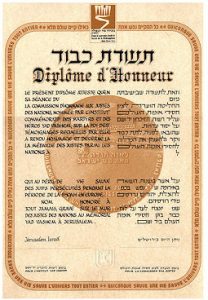
From the Webmaster:
If anyone knows the names and details of other heroes whose stories should be included on this page, please email them to me (click on the envelope symbol at the top right-hand corner). I will then pass them on for further research and future inclusion.
The saving of Jews or providing Jews with help needs to have taken place
(a) in Częstochowa or the surrounding region,
OR
(b) elsewhere by someone whose hometown was Częstochowa or in the surrounding region.
They do NOT necessarily need to have been recognised by Yad Vashem as “Righteous”.

